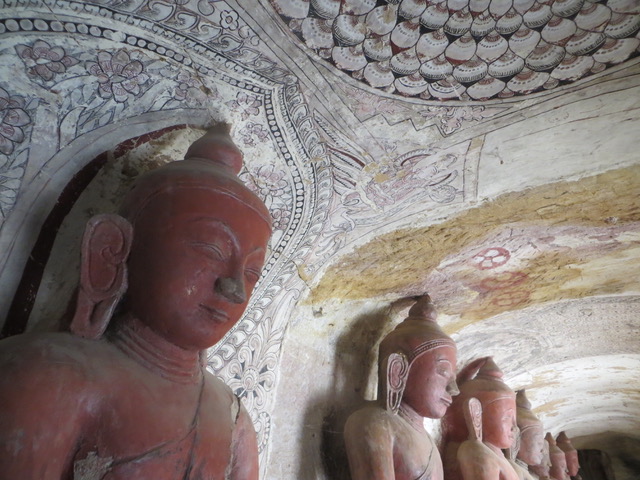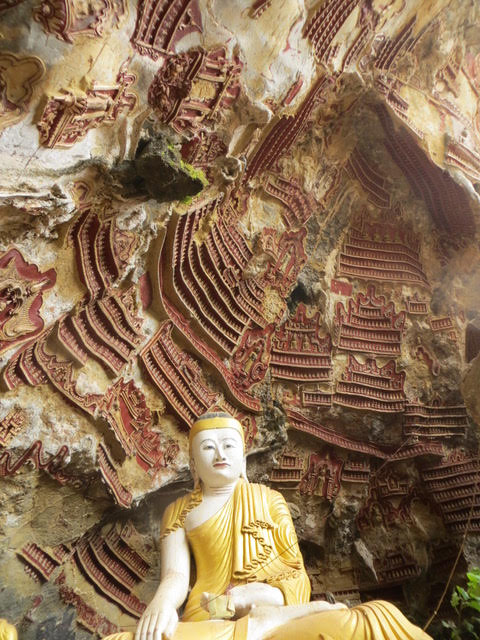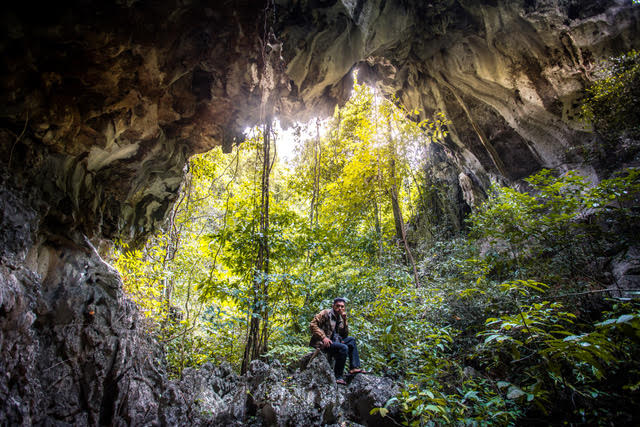Though a lot of international travel magazines still frame Myanmar as a “new” tourist destination, the first overseas visitors arrived during the nineteenth century colonial days of old Burma – and the obsession with the country’s karst probably began with those early waves of curious outsiders, at least 150 years ago. The first map of southern Myanmar’s caves dates back to 1827, though the nation still has many unmapped and unexplored cave systems due to its recent history of closed borders.
Travelers to the Big Four destinations – Yangon, Bagan, Mandalay and Inle lake – often make it to the statue-lined Pindaya caves near Kalaw in Shan state, but there are other caves in the less-visited parts of Myanmar that make for great opportunities for exploration.

Pindaya’s caves are typical of Burmese caves, in that the natural wonder of sculpted limestone has been transformed through human input into a place of Buddhist pilgrimage. According to local legend, a huge spider once held captive seven princesses until a brave archer came to their rescue. The Shwe oo Min caves, which date back to the 18th century, now hold an estimated 10,000 Buddha statues donated from individuals and groups from around the world. Scholars believe the main chamber has the largest range of shapes, sizes, and materials in the land. Amid all the bling and gilding, it is easy to overlook the tiny meditation chambers tucked away under plinths, where respite from devout pilgrims and awed tourists may be found, along with rare moments of solitude and peace.
Few visitors make it west of Mandalay to Monywa, where an hour further west the Pho Win Taung caves hold the most varied collection of Buddhist murals in Southeast Asia. On the forested ‘mountain of isolated solitary meditation’ inhabited by aesthetics and scavenging monkeys, there are 900 ‘caves’ containing Buddha statues and ornate, decorative murals with geometric designs. Some of the warm, earth toned wall paintings are 400 years old, but the unique feature of the whole hillside is that the guardian-protected caverns and alcoves are all hand-made, carved into the soft sandstone and limestone.

Closer to Mandalay, but harder to access, the Dat Daw Taung cave gained global prominence when an image captured by photographer Lin Tun taken at the site won an international award and went viral. The image, which showed natural rays of sunlight coming from outside, filtering on to a sole monk standing on the floor of the cave, brought some curious travelers to Dat Daw Taung, but it still remains a fairly tourist-free spot.
Near the town of Kyaukse, best known for its elephant dance festival held in October, getting into the cave involves a 30-minute hike uphill, and then some steps down into the cave. As the abbot told me, there are only certain days of the year when the angle of the sun and overhead weather conditions mean everything is in alignment so that “heaven’s rays” fall on the central shrine on the cave’s floor.
Dat Daw Taung is sometimes mistaken for the other photogenic cave, Sadan cave near Hpa’an, one of the longest caves in Myanmar. Its main chamber is said to be as large as a football stadium, and standing inside feels like being in a cathedral. More marvels await in the middle section, including a crystal wall, large-girth stalactites, and bats flitting around the fluted walls. The cave roof has collapsed and fallen in, allowing light to stream into one part of the much-visited pilgrimage cave, and after a 15-minute walk, the cave ends opening out onto a secret amphitheater, with a tranquil pretty lake, and fishermen with wooden skiffs waiting to take passengers through another flooded cave back toward the main entrance.
Nearby, in the picture-perfect landscape riddled with mysterious caves, snaking rivers, and limestone outcrops, Kawgun Cave is a long open cavern plastered with thousands of tiny clay tablets and carvings, some dating back to the 7thcentury.

Not in any guidebooks, there is an un-named cave hidden away in the river plains of southern Myanmar that I visited earlier this year as part of a scouting trip. After a lengthy river journey by longtail boat past cultivated fields and fishing enclosures, it was a hike skirting around the hill to the narrow cave entrance. The cave, like most in Myanmar, can only be visited outside the rainy season. You need to be fit, agile and to have an adventurous spirit to venture into this cave – and so far, only one outfit takes visitors into this off-the-beaten-track cave.
With rounded, eroded dripstone mounds, columns formed from ceiling stalactites joining floor stalagmites, and delicate frozen crystallized draperies of calcium deposits, the labyrinth cave twists and turns from dark chamber to long tunnels, with a collapsed ceiling, high arches, and rough, uneven rocks. As well as sleeping snakes and shells among the silt, the cave contains a trouser-snake, a tall, penis-like stalactite — a “phallactite,” if you will.
Myanmar is only just being “discovered” as a tourist destination, and there are efforts to open up more parts of the country to visitors from abroad. While most tourists expect the highlights are going to be pagodas and temples above ground, there is another world to be explored below.
Keith Lyons is a travel writer from New Zealand with a decade-long obsession with Myanmar. He has contributed to The Best of Myanmar, edited and co-authored Opening Up Hidden Burma, and is currently working on a guide for Bagan, and coffee-table books about Inle Lake and Mergui.




